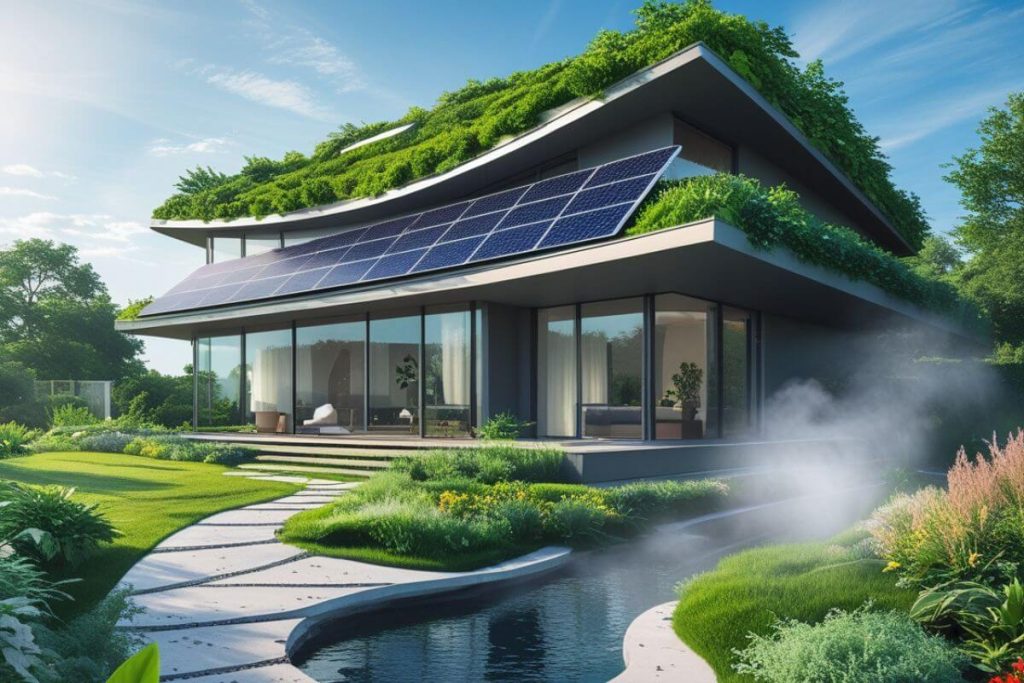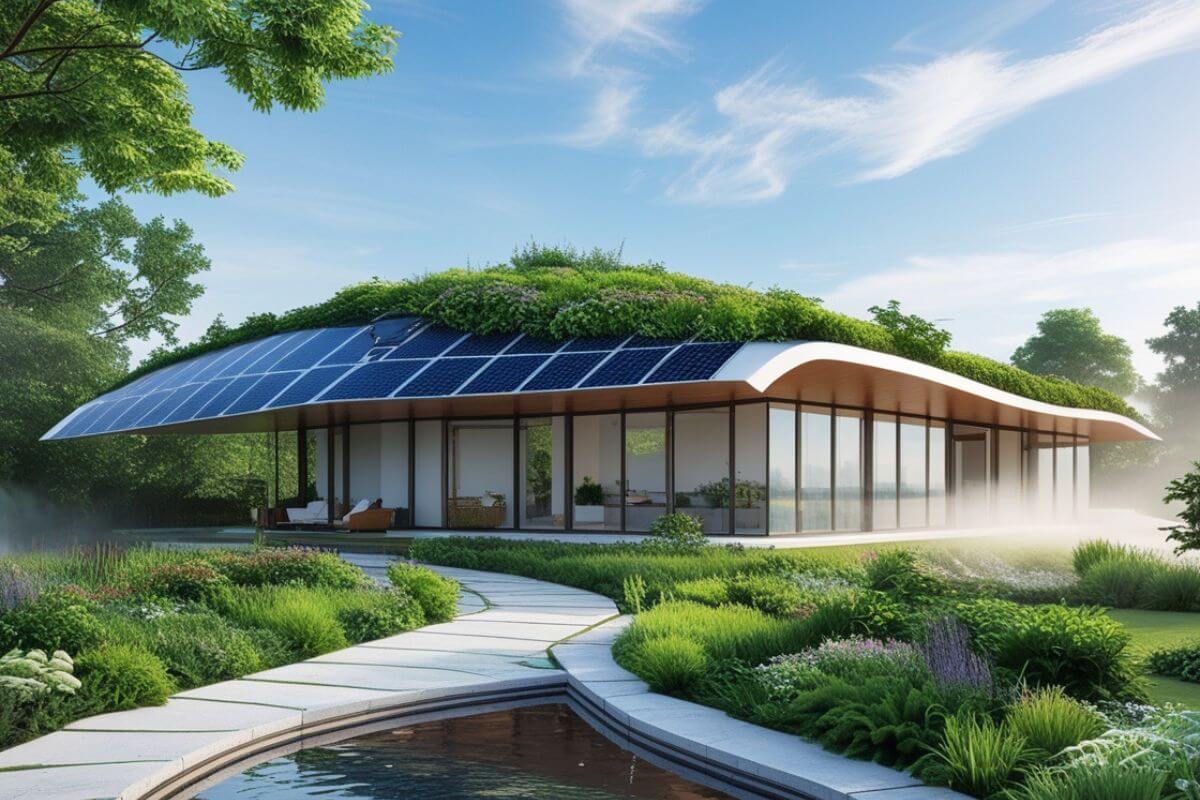Imagine living in a home that not only meets your needs but also heals the planet. A space that generates its own energy, captures rainwater, grows food, and fosters a deep connection with nature. This isn’t a far-off dream—it’s the essence of regenerative home design, a revolutionary approach to architecture and living that goes beyond sustainability to actively restore the environment. In this article, we’ll explore what regenerative home design is, why it matters, and how you can incorporate its principles into your own home. Let’s dive in!

What Is Regenerative Home Design?
Regenerative home design is about creating living spaces that give back to the environment rather than just minimizing harm. Unlike traditional sustainable design, which focuses on reducing negative impacts (think energy-efficient appliances or low-waste construction), regenerative design aims to improve ecosystems, regenerate natural resources, and enhance the well-being of both people and the planet.
At its core, regenerative home design is guided by a few key principles:
- Harmony with nature: Homes are designed to work with local ecosystems, not against them.
- Resource regeneration: Systems are put in place to restore resources like water, energy, and soil.
- Human and planetary health: The design prioritizes the physical and mental well-being of occupants while supporting the environment.
- Adaptability: Homes are built to evolve with changing climates, technologies, and needs.
Think of it like this: if sustainable design is about leaving a smaller footprint, regenerative design is about leaving a positive imprint.
Why Regenerative Home Design Matters Now
In 2025, the world is grappling with climate change, resource depletion, and urbanization challenges. According to the United Nations Environment Programme, buildings account for nearly 40% of global energy-related CO2 emissions. Meanwhile, extreme weather events are becoming more frequent, and biodiversity loss is accelerating. Regenerative home design offers a way to address these crises head-on by rethinking how we build and live.
Here’s why this approach is gaining traction:
- Climate resilience: Regenerative homes are designed to withstand floods, droughts, and heatwaves, making them future-proof.
- Resource scarcity: By generating energy, harvesting water, and recycling waste, these homes reduce reliance on strained municipal systems.
- Health benefits: Natural materials, better air quality, and biophilic design (more on that later) improve mental and physical health.
- Community impact: Regenerative homes often inspire neighborhoods to adopt eco-friendly practices, creating ripple effects.
Ready to see how this works in practice? Let’s break down the key elements of a regenerative home.
Key Features of Regenerative Home Design
Regenerative homes are like living ecosystems, carefully designed to regenerate resources and support life. Here are the core components that make them unique:
1. Energy Generation and Efficiency
Regenerative homes don’t just use less energy—they produce it. Solar panels, wind turbines, or geothermal systems can generate clean energy, often enough to power the home and even feed surplus back to the grid. For example, Tesla’s Solar Roof integrates sleek solar tiles into the home’s structure, blending aesthetics with function.
Beyond generation, these homes are hyper-efficient. Think passive design strategies like:
- Orientation: Positioning the home to maximize natural light and heat in winter while minimizing heat gain in summer.
- Insulation: Using natural materials like sheep’s wool or cork to keep temperatures stable.
- Smart systems: IoT-enabled devices that optimize energy use, like smart thermostats or automated blinds.
2. Water Harvesting and Recycling
Water is a precious resource, and regenerative homes treat it that way. Rainwater harvesting systems collect and store water for use in irrigation, flushing toilets, or even drinking (with proper filtration). Greywater systems recycle water from sinks and showers for non-potable uses, reducing waste.
For instance, the Living Building Challenge, a leading standard for regenerative design, requires homes to be water-neutral, meaning they use only what they can capture or recycle on-site. This not only conserves water but also reduces strain on local infrastructure.
3. Sustainable and Regenerative Materials
The materials used in regenerative homes are chosen for their environmental impact—or lack thereof. Instead of energy-intensive concrete or toxic plastics, designers opt for:
- Natural materials: Bamboo, reclaimed wood, or rammed earth, which sequester carbon and biodegrade naturally.
- Upcycled materials: Salvaged steel, recycled glass, or repurposed bricks that reduce waste.
- Local sourcing: Materials from nearby reduce transportation emissions and support local economies.
A great example is the Earthship, a type of regenerative home built with tires, bottles, and other recycled materials. These homes are off-grid, self-sustaining, and surprisingly beautiful.
4. Food Production
Why rely on grocery stores when your home can grow its own food? Regenerative homes often incorporate edible gardens, vertical farming, or rooftop agriculture. These systems not only provide fresh produce but also improve soil health and sequester carbon.
Aquaponics and permaculture principles are popular here, blending plants, fish, and other organisms into closed-loop systems. Imagine picking herbs from your kitchen wall or harvesting tomatoes from your backyard—regenerative design makes this a reality.
5. Biophilic Design
Biophilic design is about connecting people with nature, and it’s a cornerstone of regenerative homes. Features like living green walls, large windows with views of nature, or natural light-filled spaces boost mood and productivity. Studies from the World Green Building Council show that biophilic elements can reduce stress and improve cognitive function by up to 15%.
Even small touches—like indoor plants or natural textures like wood and stone—make a big difference. The goal is to blur the line between indoors and outdoors, creating a sense of harmony.
6. Waste Reduction and Circular Systems
Regenerative homes aim for zero waste. Composting toilets turn human waste into nutrient-rich soil. Food scraps feed compost bins or anaerobic digesters, producing biogas for cooking. Even construction waste is minimized by using modular or prefabricated designs.
The Cradle to Cradle framework inspires this approach, encouraging products and systems that can be endlessly reused or safely returned to the earth.
How to Incorporate Regenerative Design Into Your Home
Feeling inspired but wondering where to start? You don’t need to build an Earthship from scratch to embrace regenerative principles. Here are practical ways to make your home more regenerative, whether you’re renovating, building new, or just tweaking your space:
Start Small
- Install a rain barrel: Capture rainwater for your garden.
- Compost food scraps: Turn waste into nutrient-rich soil.
- Add indoor plants: Boost air quality and bring nature inside.
Upgrade Systems
- Switch to solar: Explore solar panels or solar water heaters.
- Insulate better: Add weatherstripping or upgrade to eco-friendly insulation.
- Use smart tech: Install a programmable thermostat to save energy.
Rethink Materials
- Choose natural finishes: Opt for low-VOC paints or reclaimed wood furniture.
- Support local artisans: Buy decor or materials from nearby makers.
- Avoid synthetics: Swap plastic for sustainable alternatives like bamboo or hemp.
Grow Your Own Food
- Start a container garden: Grow herbs or veggies in pots.
- Try vertical gardening: Use wall space for edible plants.
- Learn permaculture: Design a small backyard ecosystem.
Work With Professionals
If you’re building or renovating, hire architects or designers experienced in regenerative design. Certifications like LEED, Living Building Challenge, or Passive House can guide the process. Websites like ArchDaily showcase regenerative projects for inspiration.
Challenges and Considerations
Regenerative home design isn’t without hurdles. Upfront costs can be higher than conventional construction, especially for advanced systems like solar or greywater recycling. However, long-term savings on utilities and maintenance often offset these expenses. For example, a study by the International Living Future Institute found that regenerative buildings can reduce energy costs by up to 70%.
Another challenge is navigating local regulations. Some areas have outdated zoning laws that restrict rainwater harvesting or off-grid systems. Researching local codes and working with knowledgeable contractors can help.
Finally, regenerative design requires a mindset shift. It’s about prioritizing long-term impact over short-term convenience, which can feel daunting. But every small step counts—whether it’s planting a garden or choosing sustainable materials.
The Future of Regenerative Home Design
As climate challenges intensify, regenerative home design is poised to become mainstream. Innovations like 3D-printed homes, algae-based building materials, and AI-driven energy optimization are pushing the field forward. Governments and organizations are also stepping up: the European Green Deal aims to make buildings carbon-neutral by 2050, and similar initiatives are emerging worldwide.
On a personal level, regenerative homes empower us to live in alignment with our values. They’re a reminder that we can build a better future, one home at a time. As architect William McDonough, a pioneer of regenerative design, once said, “Design is the first signal of human intention.” What intention will your home signal?
Ready to Go Regenerative?
Whether you’re dreaming of a fully off-grid oasis or just want to make your apartment greener, regenerative home design offers endless possibilities. Start by assessing your space: What resources can you conserve or regenerate? What small changes can you make today? Websites like Green Building Council or Permaculture Research Institute are great places to learn more.
Let’s build homes that don’t just shelter us but also nurture the planet. Have you tried any regenerative design ideas in your home? Share your thoughts in the comments below, or reach out to a local green architect to start your journey. Together, we can create a world where every home is a force for good.
This article is for informational purposes only. Always consult professionals for construction, renovation, or legal advice related to regenerative home design.
